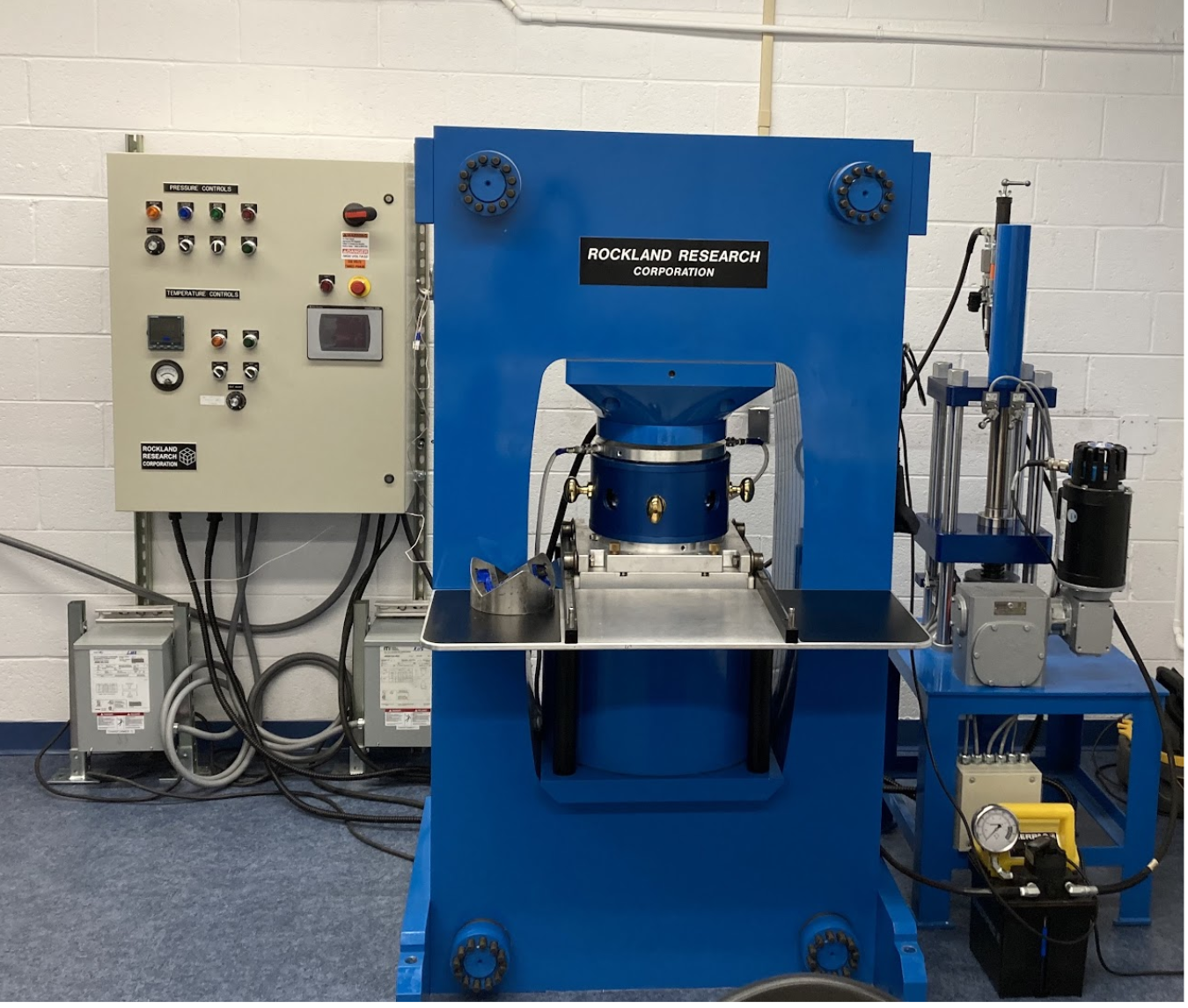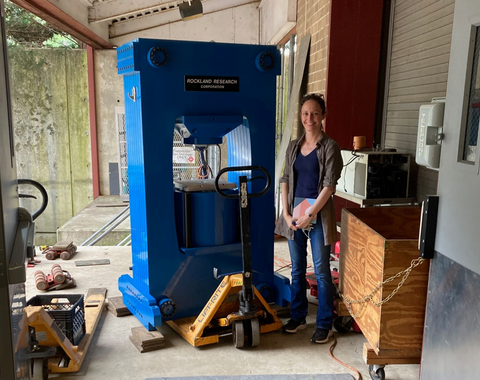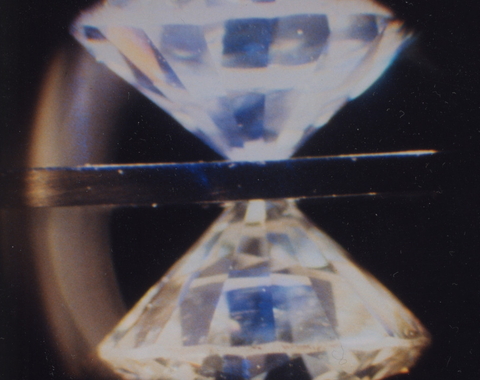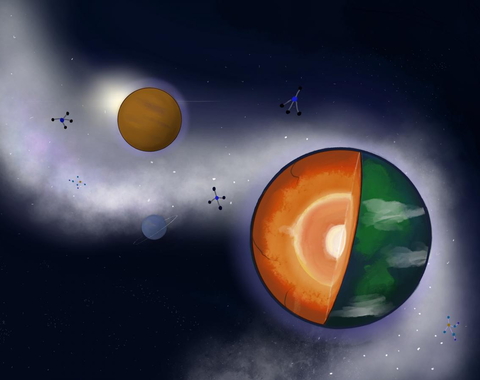Dr. Pommier is a civil engineer and geoscientist by training. She received her Ph.D. in November 2009 from the CNRS-University of Orleans, France, working on the electrical properties of magmas, with application to Mount Vesuvius, Italy. After postdoctoral experiences at MIT and ASU, she became a faculty member at UC San Diego-Scripps Institution of Oceanography in 2014, where she built a high-pressure lab. She received an NSF-CAREER award in 2018 and was promoted with tenure in July 2020. One year later, she moved to the Earth and Planets Laboratory at the Carnegie Institution for Science.
As a mineral physicist, Dr. Pommier conducts experiments in the lab to probe the physical and chemical properties of mantle and core analogs. The aim is to understand the present-day composition and evolution of terrestrial planets and moons (such as the Earth, the Moon, Mars, and Mercury). One specialty of her lab is to perform in situ electrical measurements on samples at high pressures and temperatures.
At Carnegie, she is also working with several EPL colleagues to perform optical and acoustic measurements in the press. She works in close collaboration with researchers in geophysics, planetary sciences, geodynamics, and chemistry.
Research
Pommier and her colleagues developed a new type of experimental setup utilizing a multi-anvil large volume press and synchrotron X-ray radiography at Beamline 13-ID-D of GSECARS of the Advanced Photon Source, Argonne National Laboratory. This setup is designed for simultaneous measurements of three structure-sensitive thermophysical properties (diffraction, electrical resistivity, viscosity).
This new setup advances research about melt distribution and mobility at conditions relevant to planetary interiors. The far-reaching impact extends to scientists of all disciplines that seek to understand the transport properties of solid and molten materials. The impedance spectroscopy setup, funded by an NSF-EAR CAREER grant awarded to A. Pommier, is available to GSECARS users at APS. The multi-anvil cell assemblies used for electrical measurements are available to the scientific community via COMPRES.
Related publication: Pommier, Leinenweber, Pirotte, Yu, and Wang, 2020 (High-Pressure Research)
Magnetotelluric data have been increasingly used to image subduction zones. Models of electrical resistivity commonly show features related to the release of fluids at several depths through the systems imaged, consistent with thermal and petrologic models of dehydration of the downgoing slab.
Pommier and her colleagues hypothesized that regions where very strong conductive anomalies are observed in the mantle wedge at depths ~80-100km are related to the subduction of anomalous seafloor, either related to excessive fracturing of the crust (e.g., fracture zones), subduction of seamounts or other ridges and areas of high relief. These features deform the seafloor prior to entering the trench, permitting more widespread serpentinization of the mantle than would otherwise occur. An alternative explanation is that the large conductors represent melts with higher contents of crustal-derived volatiles (such as C and H) , suggesting in particular locally higher fluxes of carbon into the mantle wedge, perhaps also associated with subduction of anomalous seafloor structures with greater degrees of hydrothermal alteration.
Her electrical experiments up to 10 GPa also showed that lawsonite dehydration could contribute to (but not solely explain) high conductivity anomalies observed in the Cascades by releasing aqueous fluid at a depth (~50 km) consistent with the basalt-eclogite transition. In subduction settings where the incoming plate is older and cooler (e.g., Japan), lawsonite remains stable to great depth. In these cooler settings, lawsonite could represent a vehicle for deep water transport and the subsequent triggering of melt that would appear electrically conductive, though it is difficult to uniquely identify the contributions from lawsonite on field electrical profiles in these more deep-seated domains.
Related publications: Pommier, 2014 (EPS); Pommier & Evans, 2017 (Geosphere); Pommier et al., 2019 (JGR-Solid Earth)
The thermal state and chemistry of the metallic core of terrestrial planets and moons govern their evolution and in particular, the intrinsic magnetic field. Though it is accepted that Mars has a sulfur-rich metallic core, its chemical and physical state as well as its time evolution are still unconstrained and debated. Several lines of evidence indicate that an internal magnetic field was once generated on Mars and that this field decayed around 3.7-4.0 Gyrs ago. The standard model assumes that this field was produced by a thermal (and perhaps chemical) dynamo operating in the Martian core.
By studying the electrical resistivity of minerals under high pressure, Pommier and her colleagues are able to determine the characteristics of planetary cores and constrain the chemical evolution of planets.
Related publications: Davies & Pommier, 2018 (EPSL); Pommier, 2018 (EPSL); Pommier et al., 2018 (Icarus); Pommier et al., 2019 (EPSL); Pommier, 2020 (Am. Mineral.); Pommier et al., 2020 (JGR-Planets)
In these studies, Pommier explores the role of plastic shear deformation on electrical properties at upper mantle conditions. In 2015, Pommier investigated the electrical conductivity of deformed partially molten rocks with application to geophysical results in the asthenosphere. In 2018, she reported a systematic experimental investigation of the effect of shear deformation on the electrical conductivity of polycrystalline olivine.
CV
- Ph.D. (experimental petrology), Institut des Sciences de la Terre d’Orléans, CNRS- University of Orléans, France, 2009.
Thesis Title: Electrical properties of magmas. Advisors: Michel Pichavant, Fabrice Gaillard. - M.Sc. (mineral resources and lithospheric transfers), University of Orléans, France, 2006.
Thesis Title: Study of the electrical properties of hydrous magmas under pressure: application to Mt. Vesuvius. Supervisor: Fabrice Gaillard (CNRS- ISTO, France) - Engineer Degree (civil engineering, geology, environment, soil and fluid mechanics), Polytech' Orléans engineering school, France, 2006.
- B.Sc. (volcanology), Polytech’Orléans, France - INGV Palermo, Italy, 2005. B.Sc.
Thesis Title: Sampling and analyzing natural fluids on active volcanic systems of South Italy. Supervisor: Walter d’Alessandro (INGV Palermo, Italy)
- NSF CAREER Award, 2018
- COMPRES Distinguished Lecturer, 2018-2019
- COMPRES Elector at the University of California at San Diego, 2016-present
- Member of the COMPRES Nominating Committee, 2018 and 2019
- Member of the COMPRES Facilities Committee, 2016-2019
- Member of the COMPRES Program Committee for the 2016 Annual Meeting
- Alexander von Humboldt Fellowship, BGI, Germany, Summer 2015
- Member of the Program Committee, Electro-Magnetic Induction Workshop (EMIW), 2014
- SESE Exploration Postdoctoral Fellowship, ASU, 08/2012-06/2014
- Staff scientist (07/01/2021-present), Carnegie Institute for Science, Earth & Planets Laboratory, Washington, DC (USA).
- Adjunct Professor (07/01/2021-present), University of California - San Diego, Scripps Institute of Oceanography, La Jolla, CA (USA).
- Affiliated Faculty (07/2018-present), University of California - San Diego, Materials Science and Engineering Program, La Jolla, CA (USA).
- Associate Professor (Tenured) (07/01/2020-06/30/2021), University of California - San Diego, Scripps Institute of Oceanography, Cecil H. and Ida M. Green Institute of Geophysics and Planetary Physics, La Jolla, CA (USA).
- Adjunct Professor (02/2020-2021), Woods Hole Oceanographic Institution (WHOI), Woods Hole, MA (USA).
- Assistant Professor (07/01/2014-06/30/2020), University of California - San Diego, Scripps Institute of Oceanography, Cecil H. and Ida M. Green Institute of Geophysics and Planetary Physics, La Jolla, CA (USA).
- Postdoctoral Associate (09/2011-08/2012) - SESE Exploration Postdoctoral Fellow (08/2012-06/2014), Arizona State University, School of Earth and Space Exploration, Tempe, AZ (USA)
- Visiting Scientist (04/2012- 04/2013, 04/2014-05/2015), Lunar and Planetary Institute, Houston, TX (USA)
- Postdoctoral Research Associate (01/2010-08/2011), Massachusetts Institute of Technology, Department of Earth, Atmospheric and Planetary Sciences, Cambridge, MA (USA)
- Teaching experience (09/2006-09/2009), Polytech’Orléans engineering school (“monitorat”: 64hr/yr), Orléans (France)
Pommier Experimental Planetary Lab (PEPL)

- Multi-anvil apparatus
The lab houses an 1000-ton press from Rockland Research equipped with a Walker-type multi-anvil module.
- Piston-cylinder apparatus
A 250-ton press (Boyd and England type end-loaded piston-cylinder, manufactured by Rockland Research).
- Gain/Phase Analyzer - Impedance spectrometer
Electrical measurements are conducted under pressure and temperature using an impedance spectrometer. The lab is equipped with a Solartron 1260A gain/phase analyzer from Ametek directly connected to a PC for real-time measurements.
- 1 atm gas mixing furnace
Deltech atmospheric furnace working with air or CO2-CO gas mixtures.
- Nikon reflected and transmitted light polarizing microscope
- Struers Secotom cut-off machine
- Foredom hang up motor with diamond tools
- 1700°C Lindberg box furnace
- 1100°C Lindberg box furnace
- Well Diamond saw
- Binocular microscope
- Struers polishing machine
- Vacuum oven



